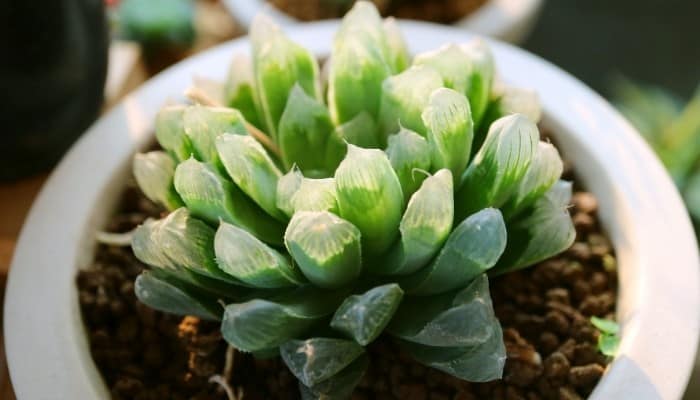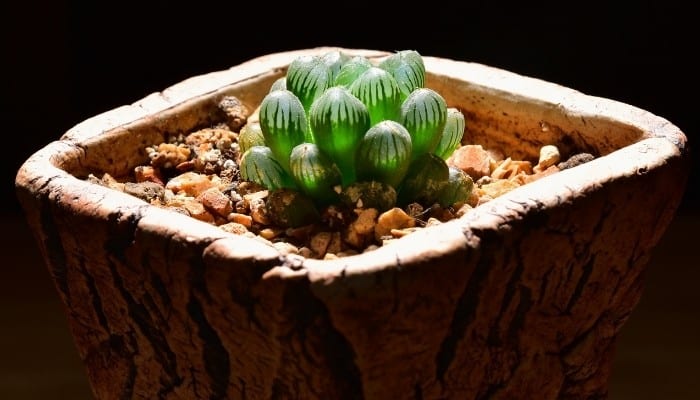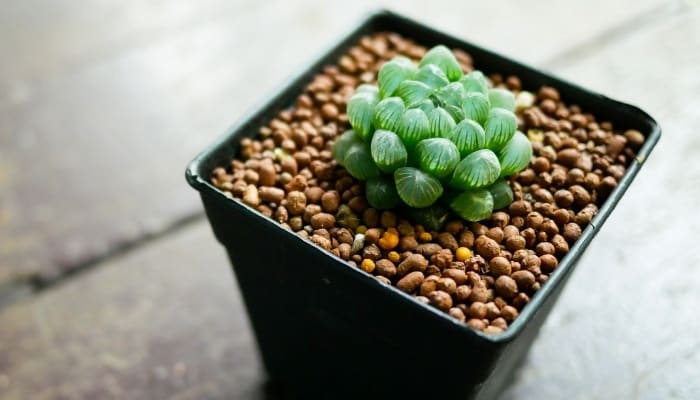The allure of the Haworthia Cooperi lies in its broad range of shapes and sizes.
You can have two Haworthias in your home, and many of your visitors won’t even realize that they are the same species of plant. There’s so much variation within the species.
Originating in South Africa, the Haworthia Cooperi are a group of gorgeous succulents that have become popular with home plant growers the world over.
This article will go over all the ins and outs of caring for a Haworthia Cooperi.
What Is Haworthia Cooperi?
The Haworthia Cooperi is a succulent plant that is similar to an aloe vera. Its transparent leaves are the plant’s most distinctive feature, which grows in a tight rosette pattern.
It’s a pretty rare plant, not one that you can find in any gardening store, which makes it sought after by collectors.
The many different varieties of plants in the Haworthia family include:
- Haworthia Gordoniana
- Haworthia Pilifera
- Haworthia Leightonii
- Haworthia Retusa
- Haworthia Obtusa
- Haworthia Cymbiformis
- Haworthia Limifolia
- Haworthia Reinwardtii
The Haworthia Cooperi is the most commonly cultivated species of the Haworthia family, but Haworthia Cymbiformis, Haworthia Obtusa, and Haworthia Limifolia are also popular.
In terms of nonscientific names, the Haworthia Cooperi goes by several:
| Star Window Plant | Window Haworthia | Pearl Plant |
| Cushion Aloe | Zebra cactus | Cooper’s Haworthia |
Personally, I’ve always called mine a Star Window Plant.
What Are the Common Varieties of Haworthia Cooperi?
Just as there are many different types of plants in the Haworthia family, there are many different varieties (also known as ‘cultivars’) with the single species of Haworthia Cooperi. We’ll go over some of the most popular in this section: Pilifera, Truncata, Tenera, Venusta, Leightonii.
Haworthia Cooperi ‘Pilifera’

This variety of Haworthia Cooperi grows low to the ground, with small triangular leaves that have a great degree of transparency.
A healthy Pilifera has bluish-green leaves that are very translucent. Sticking to the ground and growing outwards, a Pilifera can grow up to 12 inches in diameter.
Haworthia Cooperi ‘Truncata’

The Turncata is the strangest looking of the Haworthia plants, which makes it one of the most popular for plant owners. It looks exactly like a bunch of green grapes in a pile, with ovular leaves that grow in a budge up to 3 inches in diameter.
Even better, large white flowers grow in the summer, rising twelve inches on long, thin stems.
Haworthia Cooperi ‘Tenera’
Completely different than the chaotic Truncata, the Haworthia cooperi ‘Tenera’ grows symmetrically, with large triangular leaves growing outwards from the middle of the plant.
They are largest on the outside and get progressively smaller towards the center. The leaves are only slightly translucent and will take a long time to reach their longest size.
Haworthia Cooperi ‘Venusta’
This variety of Haworthia Cooperi looks a bit like a cactus, with triangular leaves that have white coloration and toothed margins. They are triangular and 2 inches long when fully grown.
Haworthia Cooperi ‘Leightonii’
The Leightonii is the largest popularly cultivated variety of the Haworthia Cooperi, with large triangular leaves that grow upward. It isn’t the most translucent variety, but some plants have a beautiful red coloring on the underside of the leaves. The top of the leaves is a bright green color.
Caring for a Haworthia Cooperi Plant Properly
Although Haworthia Cooperis are quite low maintenance, several conditions ensure your plant thrives. Once you get properly set up, then you can have a Haworthia that’s easy to take care of and will last a long time.
Light
For your Haworthia Cooperis to thrive, you need to find a place that has a lot of light but isn’t directly in the sun. This means you don’t want to place your Haworthia right on the window sill, but you might want to put it on a table nearby the window. Too much sun will dry out the plant and cause discoloration.
Interestingly, when growing in the wild, a Haworthia Cooperi usually grows underneath the shade of a larger tree. So try to simulate this lighting condition to the best degree you can.
Temperature
There is a quite wide range of temperatures at which Haworthia Cooperi is comfortable and able to grow.
In the summer, these plants like to be in warm, but not hot, temperatures while they’re growing. They can grow in temperatures as low as 10 degrees Celcius.
Be careful to keep your succulents in environments over 4 degrees Celcius, as this is the point at which the plant will start to experience freezing damage.
Watering
Like most other succulents, one of the most important parts of keeping them healthy is controlling when you water them and how much water you give them.
During the summer, when temperatures are high and the plant is growing, you should water your Haworthia Cooperi once a day. Don’t fill the pot with water, though, and make sure that there is a hole for drainage at the bottom of it. Before you water again, make sure the soil has completely dried since the previous day.
Soil
Although Haworthia Cooperi grow in sandy environments, I wouldn’t recommend adding sand to the mix of soil to mimic this. That’s because sand tends to sink through the soil in your pot and clog the drainage hole, which can lead to serious problems with over-watering your plant.
Instead, it’s best to use a soil mix specifically for succulents. You can buy one of these at a garden store or online. On Amazon, the Next Gardener Store’s Organic Succulent and Cactus Soil Mix is a great product that I use for my Haworthias and other succulents.
You can also make your own succulent mix by mixing potting soil, coarse sand, and Pumice. You’ll want to use three parts potting soil, two parts coarse sand, and one part pumice. Note that you can substitute perlite for the pumice and surface or poultry grit for the coarse sand. If you have any of these substitutes on hand, you can skip buying their counterpart.
Transplanting
Transplanting a Haworthia Cooperi is easy to do but not usually necessary because these plants are so slow-growing and have an upper limit on how big they grow.
If you do want to transplant your succulent, perhaps to move it to a nice pot, just make sure to use the proper soil in the new pot.
Grooming
The only grooming necessary for a Haworthia Cooperi is getting rid of dead leaves as they appear. For variants like the Tenera and Pilifera, which grow outwards from the center, these leaves will usually appear on the outside of the plant.
Avoiding Pests
Most houseplant pets don’t have much of an impact on Haworthia Cooperi. There is a chance your plant can provide a good environment for fungus gnats if you overwater it. Though the small flies won’t eat or damage your plant, they can spread to other plants nearby your Haworthias and cause problems.
To avoid such an infestation, be sure that your pot has adequate drainage and that you don’t overwater it.
Do Haworthia Cooperi Die After Flowering?
None of the varieties of Haworthia Cooperi die after flowering. Since they are not monocarpic, they can survive for many years of seasonal blooming.
Can You Propagate Haworthia Cooperi?
Yes, like many other succulents, you can propagate a Haworthia Cooperi.
There are two ways to propagate a Haworthia Cooperi. The first is using offshoots of the plant that spring up around it. The second uses cut leaves to sprout a new plant. Both methods have their advantages and disadvantages, which we’ll go over in this section.
Propagating from Leaves
To propagate your Haworthia Cooperi using a leaf, cut off a healthy-looking leaf using sharp scissors. Making a clean cut is important, both for the health of the larger plant and the likelihood of the new plant taking root.
After cutting the leaf, give it a few days to dry out and ‘heal’ before planting it in succulent soil. New roots should form within a few weeks.
Propagating from Offshoots
An offshoot is a smaller plant that starts to grow beside the larger mother plant. They are still connected to the succulent and share the same root system. Some people refer to these as ‘pups.’
When propagating from an offshoot, detach it from the mother plant using sharp scissors. You should plant your pups as soon as possible after you cut them, unlike the leaves. Once again, though, be sure to use succulent soil rather than regular potting soil. Within a few weeks, your new plant will have its root system.
In Sum
Any variety of Haworthia Cooperi you can get your hands on is going to be beautiful and easy-to-care-for addition to your home garden. Even better, you can always propagate a leaf or two for a great gift for any of your friends.

